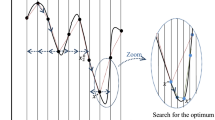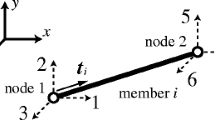Abstract
Two new methods for finding global minimum points are applied to several truss and frame structural design problems. Basic ideas and procedures of the methods are explained. One of the methods finds many local minimum solutions while the second method is concerned mainly with finding only the global solution (however, it may find other local minima as well). A set of twenty-eight structural design test problems is devised by using two materials (steel and aluminium) and three cross-sectional shapes. The problems are solved with the two methods, and the results are analysed. Comparisons are made for the results with the truss and frame model for the same structure, use of steel or aluminium as the construction material, and use of different cross-sectional shapes. It is shown that many structural optimization problems possess several local minima, and so the global optimization methods can be useful for their solution. However, the computational effort to find a global solution can be substantial because many local minimizations must be performed. It is concluded that both the methods are useful for finding global minimum solutions for structural optimization problems.
Similar content being viewed by others
Abbreviations
- A i :
-
Cross-sectional area of thei-th member
- αi :
-
A parameter relating the area and moment of inertia of thei-th member
- δi, δiO :
-
Calculated displacement and its limit for thei-th degree of freedom
- γ:
-
A reduction factor used in the zooming method
- E :
-
Young's modulus
- F le :
-
Euler stress divided by a factor of safety
- F *G :
-
The global minimum value for the cost function
- F *W :
-
Cost function value at the worst local minimum point
- f a,F a :
-
Calculated and allowable axial stresses
- f b,F b :
-
Calculated and allowable bending stresses
- f s,F s :
-
Calculated and allowable shear stresses
- F y :
-
Yield stress
- F yc,F yt,F ys :
-
Yield stress in compression, tension and shear, respectively
- h :
-
Total height of anI-beam
- I i :
-
Moment of inertia of thei-th member
- L i :
-
Length of thei-th member
- R :
-
Mean radius of the tube
- ρi :
-
Material density of thei-th member
- t :
-
Thickness of the tube
- t f :
-
Flange thickness of anI-beam
- F :
-
Target level for the cost function at the global minimum point
- t w :
-
Web thickness of anI-beam
- ω, ωL :
-
Natural frequency of the structure and its lower limit
- ω:
-
Flange width of anI-beam
- W :
-
Weight of the structure in kips
- x:
-
Design variable vector of dimensionn
- x* :
-
A local minimum point for the cost function
- x * G :
-
A global minimum point for the cost function
References
AA 1986:Construction manual series, Sec. 1, No. 30. Washington, D.C.: The Aluminum Association Inc.
AISC 1989:Manual of steel construction: allowable stress design, 9th Edition. American Institute of Steel Construction
Arora, J.S. 1989:Introduction to optimum design. New York: McGraw-Hill
Arora, J.S. 1990a: Global optimization methods for engineering design.Proc. 31st AIAA/ASME/ASCE/AHS/ASC Structures, Structural Dynamics and Materials Conf. (held at Long Beach, CA)
Arora, J.S. 1990b: Computational design optimization: a review and future directions.Structural Safety 7, 131–148
Arora, J.S.; Elwakeil, O.A.; Chahande, A.I.; Hsieh, C.C. 1995: Global optimization methods for engineering applications: a review.Struct. Optim. 9, 137–159
Belegundu, A.D.; Arora, J.S. 1982: A study of mathematical programming methods for structural optimization.Technical Report No: ODL-82.04, Optimal Design Laboratory, The University of Iowa
Elwakeil, O.A. 1995:Algorithms for global optimization and their application to structural optimization problems. Ph.D. Dissertation, The University of Iowa
Elwakeil, O.; Arora, J.S. 1991: Numerical experiments with three global optimization methods.Technical Report, Optimal Design Laboratory, The University of Iowa
Elwakeil, O.A.; Arora, J.S. 1996: Two algorithms for global optimization of general NLP problems. Int. J. Num. Meth. Eng. (to appear)
Haftka, R.T.; Gürdal, Z. 1992:Elements of structural optimization. Boston: Kluwer
Haug, E.J.; Arora, J.S. 1979:Applied optimal design: mechanical and structural systems. New York: John Wiley and Sons
Lim, O.K.; Arora, J.S.; Thanedar, P.B. 1985: Optimal design of plane frames with the program RQP.Technical Report No. ODL-85.25, Optimal Design Laboratory, The University of Iowa
Nakamura, Y. 1966:Optimum design of frame structures using linear programming. M.S. Thesis MIT, Cambridge, MA
Sepulveda, A.E.; Schmit, L.A. 1993: Approximation-based global optimization strategy for structural synthesis.AIAA J. 31, 180–188
Vanderplaats, G.N. 1984:Numerical optimization techniques for engineering design with applications. New York: McGraw-Hill
Author information
Authors and Affiliations
Rights and permissions
About this article
Cite this article
Elwakeil, O.A., Arora, J.S. Global optimization of structural systems using two new methods. Structural Optimization 12, 1–10 (1996). https://doi.org/10.1007/BF01270438
Received:
Issue Date:
DOI: https://doi.org/10.1007/BF01270438




